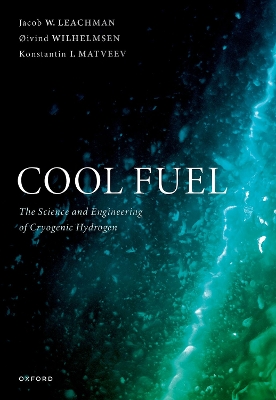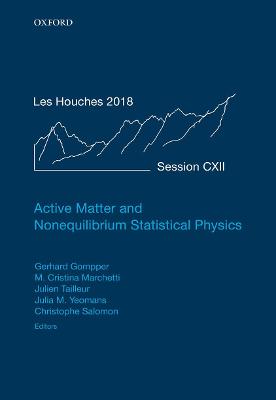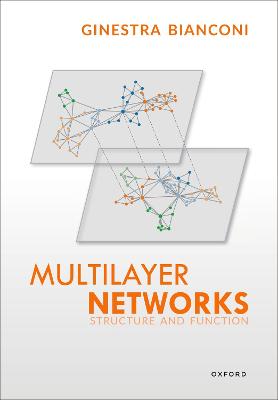Statistical Mechanics: Entropy, Order Parameters, and Complexity
 -10%
portes grátis
-10%
portes grátis
Statistical Mechanics: Entropy, Order Parameters, and Complexity
Sethna, James P.
Oxford University Press
01/2021
496
Mole
Inglês
9780198865254
15 a 20 dias
1012
Descrição não disponível.
Preface
Contents
List of figures
What is statistical mechanics?
1.1: Quantum dice and coins
1.2: Probability distributions
1.3: Waiting time paradox
1.4: Stirling>'s formula
1.5: Stirling and asymptotic series
1.6: Random matrix theory
1.7: Six degrees of separation
1.8: Satisfactory map colorings
1.9: First to fail: Weibull
1.10: Emergence
1.11: Emergent vs. fundamental
1.12: Self-propelled particles
1.13: The birthday problem
1.14: Width of the height distribution
1.15: Fisher information and Cram?erDSRao
1.16: Distances in probability space
Random walks and emergent properties
2.1: Random walk examples: universality and scale invariance
2.2: The diffusion equation
2.3: Currents and external forces
2.4: Solving the diffusion equation
Temperature and equilibrium
3.1: The microcanonical ensemble
3.2: The microcanonical ideal gas
3.3: What is temperature?
3.4: Pressure and chemical potential
3.5: Entropy, the ideal gas, and phase-space refinements
Phase-space dynamics and ergodicity
4.1: Liouville>'s theorem
4.2: Ergodicity
Entropy
5.1: Entropy as irreversibility: engines and the heat death of the Universe
5.2: Entropy as disorder
5.3: Entropy as ignorance: information and memory
Free energies
6.1: The canonical ensemble
6.2: Uncoupled systems and canonical ensembles
6.3: Grand canonical ensemble
6.4: What is thermodynamics?
6.5: Mechanics: friction and fluctuations
6.6: Chemical equilibrium and reaction rates
6.7: Free energy density for the ideal gas
Quantum statistical mechanics
7.1: Mixed states and density matrices
7.2: Quantum harmonic oscillator
7.3: Bose and Fermi statistics
7.4: Non-interacting bosons and fermions
7.5: MaxwellDSBoltzmann 's regression hypothesis and time correlations
10.5: Susceptibility and linear response
10.6: Dissipation and the imaginary part
10.7: Static susceptibility
10.8: The fluctuation-dissipation theorem
10.9: Causality and KramersDSKr?onig
Abrupt phase transitions
11.1: Stable and metastable phases
11.2: Maxwell construction
11.3: Nucleation: critical droplet theory
11.4: Morphology of abrupt transitions
Continuous phase transitions
12.1: Universality
12.2: Scale invariance
12.3: Examples of critical points
A Appendix: Fourier methods
A.1: Fourier conventions
A.2: Derivatives, convolutions, and correlations
A.3: Fourier methods and function space
A.4: Fourier and translational symmetry
References
Index
Contents
List of figures
What is statistical mechanics?
1.1: Quantum dice and coins
1.2: Probability distributions
1.3: Waiting time paradox
1.4: Stirling>'s formula
1.5: Stirling and asymptotic series
1.6: Random matrix theory
1.7: Six degrees of separation
1.8: Satisfactory map colorings
1.9: First to fail: Weibull
1.10: Emergence
1.11: Emergent vs. fundamental
1.12: Self-propelled particles
1.13: The birthday problem
1.14: Width of the height distribution
1.15: Fisher information and Cram?erDSRao
1.16: Distances in probability space
Random walks and emergent properties
2.1: Random walk examples: universality and scale invariance
2.2: The diffusion equation
2.3: Currents and external forces
2.4: Solving the diffusion equation
Temperature and equilibrium
3.1: The microcanonical ensemble
3.2: The microcanonical ideal gas
3.3: What is temperature?
3.4: Pressure and chemical potential
3.5: Entropy, the ideal gas, and phase-space refinements
Phase-space dynamics and ergodicity
4.1: Liouville>'s theorem
4.2: Ergodicity
Entropy
5.1: Entropy as irreversibility: engines and the heat death of the Universe
5.2: Entropy as disorder
5.3: Entropy as ignorance: information and memory
Free energies
6.1: The canonical ensemble
6.2: Uncoupled systems and canonical ensembles
6.3: Grand canonical ensemble
6.4: What is thermodynamics?
6.5: Mechanics: friction and fluctuations
6.6: Chemical equilibrium and reaction rates
6.7: Free energy density for the ideal gas
Quantum statistical mechanics
7.1: Mixed states and density matrices
7.2: Quantum harmonic oscillator
7.3: Bose and Fermi statistics
7.4: Non-interacting bosons and fermions
7.5: MaxwellDSBoltzmann 's regression hypothesis and time correlations
10.5: Susceptibility and linear response
10.6: Dissipation and the imaginary part
10.7: Static susceptibility
10.8: The fluctuation-dissipation theorem
10.9: Causality and KramersDSKr?onig
Abrupt phase transitions
11.1: Stable and metastable phases
11.2: Maxwell construction
11.3: Nucleation: critical droplet theory
11.4: Morphology of abrupt transitions
Continuous phase transitions
12.1: Universality
12.2: Scale invariance
12.3: Examples of critical points
A Appendix: Fourier methods
A.1: Fourier conventions
A.2: Derivatives, convolutions, and correlations
A.3: Fourier methods and function space
A.4: Fourier and translational symmetry
References
Index
Este título pertence ao(s) assunto(s) indicados(s). Para ver outros títulos clique no assunto desejado.
Preface
Contents
List of figures
What is statistical mechanics?
1.1: Quantum dice and coins
1.2: Probability distributions
1.3: Waiting time paradox
1.4: Stirling>'s formula
1.5: Stirling and asymptotic series
1.6: Random matrix theory
1.7: Six degrees of separation
1.8: Satisfactory map colorings
1.9: First to fail: Weibull
1.10: Emergence
1.11: Emergent vs. fundamental
1.12: Self-propelled particles
1.13: The birthday problem
1.14: Width of the height distribution
1.15: Fisher information and Cram?erDSRao
1.16: Distances in probability space
Random walks and emergent properties
2.1: Random walk examples: universality and scale invariance
2.2: The diffusion equation
2.3: Currents and external forces
2.4: Solving the diffusion equation
Temperature and equilibrium
3.1: The microcanonical ensemble
3.2: The microcanonical ideal gas
3.3: What is temperature?
3.4: Pressure and chemical potential
3.5: Entropy, the ideal gas, and phase-space refinements
Phase-space dynamics and ergodicity
4.1: Liouville>'s theorem
4.2: Ergodicity
Entropy
5.1: Entropy as irreversibility: engines and the heat death of the Universe
5.2: Entropy as disorder
5.3: Entropy as ignorance: information and memory
Free energies
6.1: The canonical ensemble
6.2: Uncoupled systems and canonical ensembles
6.3: Grand canonical ensemble
6.4: What is thermodynamics?
6.5: Mechanics: friction and fluctuations
6.6: Chemical equilibrium and reaction rates
6.7: Free energy density for the ideal gas
Quantum statistical mechanics
7.1: Mixed states and density matrices
7.2: Quantum harmonic oscillator
7.3: Bose and Fermi statistics
7.4: Non-interacting bosons and fermions
7.5: MaxwellDSBoltzmann 's regression hypothesis and time correlations
10.5: Susceptibility and linear response
10.6: Dissipation and the imaginary part
10.7: Static susceptibility
10.8: The fluctuation-dissipation theorem
10.9: Causality and KramersDSKr?onig
Abrupt phase transitions
11.1: Stable and metastable phases
11.2: Maxwell construction
11.3: Nucleation: critical droplet theory
11.4: Morphology of abrupt transitions
Continuous phase transitions
12.1: Universality
12.2: Scale invariance
12.3: Examples of critical points
A Appendix: Fourier methods
A.1: Fourier conventions
A.2: Derivatives, convolutions, and correlations
A.3: Fourier methods and function space
A.4: Fourier and translational symmetry
References
Index
Contents
List of figures
What is statistical mechanics?
1.1: Quantum dice and coins
1.2: Probability distributions
1.3: Waiting time paradox
1.4: Stirling>'s formula
1.5: Stirling and asymptotic series
1.6: Random matrix theory
1.7: Six degrees of separation
1.8: Satisfactory map colorings
1.9: First to fail: Weibull
1.10: Emergence
1.11: Emergent vs. fundamental
1.12: Self-propelled particles
1.13: The birthday problem
1.14: Width of the height distribution
1.15: Fisher information and Cram?erDSRao
1.16: Distances in probability space
Random walks and emergent properties
2.1: Random walk examples: universality and scale invariance
2.2: The diffusion equation
2.3: Currents and external forces
2.4: Solving the diffusion equation
Temperature and equilibrium
3.1: The microcanonical ensemble
3.2: The microcanonical ideal gas
3.3: What is temperature?
3.4: Pressure and chemical potential
3.5: Entropy, the ideal gas, and phase-space refinements
Phase-space dynamics and ergodicity
4.1: Liouville>'s theorem
4.2: Ergodicity
Entropy
5.1: Entropy as irreversibility: engines and the heat death of the Universe
5.2: Entropy as disorder
5.3: Entropy as ignorance: information and memory
Free energies
6.1: The canonical ensemble
6.2: Uncoupled systems and canonical ensembles
6.3: Grand canonical ensemble
6.4: What is thermodynamics?
6.5: Mechanics: friction and fluctuations
6.6: Chemical equilibrium and reaction rates
6.7: Free energy density for the ideal gas
Quantum statistical mechanics
7.1: Mixed states and density matrices
7.2: Quantum harmonic oscillator
7.3: Bose and Fermi statistics
7.4: Non-interacting bosons and fermions
7.5: MaxwellDSBoltzmann 's regression hypothesis and time correlations
10.5: Susceptibility and linear response
10.6: Dissipation and the imaginary part
10.7: Static susceptibility
10.8: The fluctuation-dissipation theorem
10.9: Causality and KramersDSKr?onig
Abrupt phase transitions
11.1: Stable and metastable phases
11.2: Maxwell construction
11.3: Nucleation: critical droplet theory
11.4: Morphology of abrupt transitions
Continuous phase transitions
12.1: Universality
12.2: Scale invariance
12.3: Examples of critical points
A Appendix: Fourier methods
A.1: Fourier conventions
A.2: Derivatives, convolutions, and correlations
A.3: Fourier methods and function space
A.4: Fourier and translational symmetry
References
Index
Este título pertence ao(s) assunto(s) indicados(s). Para ver outros títulos clique no assunto desejado.







